A look into traffic problems on and off campus from the students' point of view. 
▲ Cars stop, pedestrians go
: A rooftop view of the six-way crosswalk on Myungmul Street
(Photographed by Chai Kyu-min)
"IT WAS 8:50 a.m. when I got off at the bus stop in front of our school. I had a 9 o'clock class at Gwangbok Hall and I thought I could just make it if I ran, but the red light kept me from plunging ahead. Several people behind me seemed to be late for class as well and looked impatient. I looked to my right and to my left, but the road was empty except for a car coming from quite a distance. Thinking quickly, I decided that I could make it across before the car reached the crosswalk and darted forward. Just as I safely arrived at the other side of the road, I heard a dull thud and the screech of tires behind me. Dreading the scene that would appear before my eyes, I slowly turned to look back, knowing what to expect. Someone had started after me when I had lunged forward, and the car had missed me, but had unfortunately hit the person right behind."
This is a third party description of a car accident that actually did take place last fall at the crosswalk which leads from the mid-lane bus stops to Yonsei University. As Yonsei happens to be located in one of Seoul's most complicated downtown areas, Yonsei students are in imminent danger of traffic accidents on and off campus whether they are aware of it or not. The Annals has pinpointed several traffic situations on Yonsei campus and in the Shinchon area outside school in order to point out the surrounding problems and potential dangers as well as to contrive possible solutions and countermeasures.
PART 1: Traffic problems on campus
Situation 1 - A 550m wide crosswalk?
On campus, the place most likely for a traffic accident to occur is Baikyang-ro. Baikyang-ro, which stretches approximately 550m long from the Main Gate to the Baikyang-ro samguri, consists of a two-lane undivided road for cars, with a sidewalk on each side of it. As Baikyang-ro divides a considerable part of the campus into two portions with the Student Union and the Central Library - the two most frequently used buildings - on separate sides, it is inevitable that students cross the road all the time. However, considering the number of students who cross Baikyang-ro each day, shouldn't there be some kind of safety precaution such as a crosswalk?
Situation 2 - Watch out for that "autobiee"!
Scooters and motorcycles, or "autobiees" as they are called in Korea, cannot be left out when dealing with traffic safety on campus. Although an efficient way for students to go around a rather large campus, these vehicles constitute an ever-existing threat as many students streak past at breakneck speed and even use them to show off to their friends. "When I was staying at the Muak Dormitory, students riding motorcycles would zoom past at a high speed while I walked back and forth from school," recalls Kim Jeong-ha (Soph., Area of Social Science).
Even more dangerous, there are deliverymen who bring heavy loads of food to students on campus at rushing speed. "Once, when I was walking along in front of Yeonhui Hall, a jajang-myun deliveryman bumped into me while parking his motorcycle. I understand that deliverymen are in a hurry to bring their food, but they drive so recklessly," says Kim. Streaking motorcycles are intimidating to pedestrians - isn't there some way to compel these drivers to keep the speed limit of 20km per hour?
Roll Up and Pay the Toll Ever since the mid-lane bus system came into effect in July 2004, traffic congestion constituted a major problem on Sungsan-daero (the road that partly surrounds Yonsei) and resulted in an increase of cars that come in and out of the school. "We experimented how long it takes to drive the 3.5km from Yonheui IC to Keumhwa Tunnel during the morning rush hour. It took us 40 to 50 minutes," says Son Seong-moon, an officer in the Div. of General Affairs. "On the other hand, it takes approximately 3 minutes to drive from the school's North Gate to the East Gate. As a result, many drivers pass through our school instead of taking Sungsan-daero on their way to work every morning." As it is undesirable for cars that have no business at the school to crowd the school roads, Yonsei started imposing a toll of ₩3,000 on cars that simply pass through the school from 7:30 a.m. to 9:30 a.m. and from 6:00 p.m. to 8:00 p.m. The toll also applies to taxis that exit the school gate with passengers, unless the passengers can prove that they are students or faculty of the school. Instances of taxi drivers cheating students who ride into the school by telling them they have to pay the toll have occurred, so watch out! Render unto Caesar What Is Caesar's It is common knowledge that Yonsei's parking fee is high... or is it really? Back in 1994, Yonsei was the first school to charge parking fees, due to the problem of immense traffic density on campus as well as random cars parking on campus overnight. In the beginning, there were many complaints about imposing parking fees, but one by one, other schools started to follow suit. Currently, the school imposes a standard fee of ₩2,000 for the first 30 minutes, after which the parking rate becomes ₩500 for every additional 10 minutes until the total parking time exceeds two hours, when the rate increases to ₩1,000. Simply comparing Yonsei's parking fee with other schools (parking at Yonsei for one hour costs ₩3,500 whereas it costs ₩2,500 to park at Korea U), it might seem pretty expensive, but no other school has 10,000 to 12,000 cars going in and out of campus each day. It is almost unavoidable to impose parking fees high enough to discourage drivers from bringing their cars to school. However, for visitors who come for school-related matters, the school offers a discount.
Situation 3 - Park where you're supposed to!
Seeing cars with warning tickets stuck on their windows is not a rare scene on our campus. Many people park their cars in prohibited areas, but this is not an easily dismissible matter as students may think. Due to the number of cars that are illegally parked in restricted areas, the roads for cars to pass by become narrow, and can result in accidents where cars collide with each other or into pedestrians. "Now that the old parking lot which used to be next to Chunchu Hall has been fenced off, more cars park in illegal areas. However, this can be a severe problem, especially these days when all kinds of construction is going on all over campus," Son Seong-moon, an officer of the Div. of General Affairs points out.
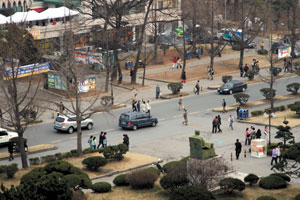
▲ Back and forth
: Students cross Baikyang-ro between the Student Union and the Central Library
(Photographed by Chai Kyu-min)
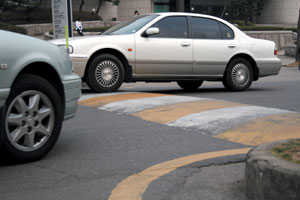
▲ Speed-bumps
: The only means of slowing cars down on Baikyang-ro
(Photographed by Chai Kyu-min)
The empire strikes back! 
▲ Speed limit: 20 kilometers per hour
(Photographed by Chai Kyu-min)
The school is well aware of the fact that there are too many cars and motorcycles on Baikyang-ro while there are so many people walking along the road at the same time. "Our ultimate goal is to rid Baikyang-ro of all cars, thus, developing 'Carless Baikyang-ro'," says Son. "At this point, however, we cannot block cars from using Baikyang-ro because we have no alternative driveway. Especially now, with the second library under construction, there is no road for construction vehicles to pass through if we block Baikyang-ro off."
Son expects the 'Carless Baikyang-ro' campaign to be completed in 2010 at the earliest. For now, the best way to ensure the safety of students walking along Baikyang-ro is to restrict speeding by using speed-bumps. "There are about four or five speed-bumps on Baikyang-ro, which meet the Ministry of Construction & Transportation standards. If it were up to me, I would install more of them, but even that is not an easy task, as drivers complain about their cars getting scratched," he says. "We also considered laying crosswalks on Baikyang-ro, but after consulting with parking managers and professors in the Dept. of Urban Planning & Engin., we decided that crosswalks would be ineffective."
As for the problem of speeding motorcycles, Son says, "Although we do not have precise statistics, about one motorcycle accident occurs every day on campus. Speeding motorcycles are a big problem because we don't have the power to impose speeding tickets or fines, while at the same time the police cannot interfere either because the school campus is private property."
In 2005, the SA (Student Association) and the Div. of General Affairs worked together in an effort to solve the problem of speeding motorcycles. "We used a 'three strikes, one out' system," says Son. "For instance, we caught drivers who did not wear safety equipment such as helmets and gloves, or drivers who went over the speed limit, or drove recklessly. Having too many people riding one motorcycle at once, or carrying a heavy load in one hand while steering with the other was also considered a breech of motorcycle safety." If someone received three warnings from the Div. of General Affairs, his or her department was notified of the fact. The system worked quite smoothly until the SA completed their term of office.
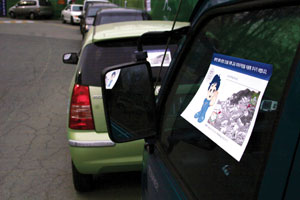 | ||
| ▲ Cars parked ilegally: New warning tickets on the windows (Photographed by Kim Young-sung) | ||
The school also changed the message on parking tickets from threatening warnings to a suggestive tone instead, along with a campus map showing where the driver can park the car instead. "Instead of making the parking tickets stick hideously on the cars, we altered it so that it would come off easily as well. These tickets cost ₩130 apiece, so it was pretty expensive, too. We are hoping that people will follow the rules now that we kindly show them where to park instead," says Son.
PART 2: Traffic problems in Shinchon 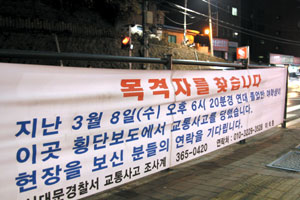
▲ Call for witness: Placard seeking a car accident witness at the Seodaemun Post Office crosswalk
Situation 1 - Mid-lane bus stop & crosswalk in front of Yonsei
After the mid-lane bus system was put into effect, many traffic accidents have occurred at the bus stops in front of Yonsei. There were as many as five deaths due to traffic accidents in the area in 2005. One likely cause for these accidents is that the lights change alternately forcing people to wait for long periods of time, whereas the width of the roads through which the mid-lane buses pass are relatively short, tempting pedestrians to jaywalk and bring about accidents.
Situation 2 - Jammed on Myungmul Street
Shinchon Myungmul Street is one place that always seems to be packed with cars and crowded with people. Most students will probably have had experience of riding a car, bus, or taxi that made frightfully slow progress on Myungmul Street. Not only is the two-lane street very narrow, but an immense number of cars flow from Shinchon Rotary and the crossroads in front of Yonsei. Moreover, illegal cars are parked intermittently all along the street, and every time the traffic light turns red, all the cars have to stop because of the "x-shaped" crosswalk (also called a six-way crosswalk), located at the Hyundai Department Store exit.
The long-arm of the law 
▲ Slow down: Speed-preventing devices installed at the mid-lane bus stops
(Photographed by Chai Kyu-min)
In an effort to solve the problem of accidents that occur at the mid-lane bus stops in front of Yonsei, the police installed speed-preventing devices, which have greatly decreased the number of accidents. "As you know, there are two lanes through which the buses can pass. In the past, when a bus stopped on one lane, other buses would sprint past in the other lane. If a person happened to cross the street at that moment, an accident would occur. Now, however, due to the speed-preventing devices installed in the second lane, such accidents do not occur as often. In fact, there has not been one single death at the Yonsei bus stop so far this year," says Seo Sang-hoon, a traffic accident inspector at Seodaemun Police Station.
The problem of traffic lights made inconvenient for pedestrians, however, remains to be solved. "It is inevitable that the traffic lights change one at a time because if they change at the same time so that pedestrians can cross the road at once, cars waiting under the tunnel across the road from the Main Gate are unable to make a left turn." Unless the whole traffic light system can be altered, the best we can do is learn to be patient.
Finding solutions required to settle the serious traffic congestion on Myungmul Street is an even more complicated task to solve as it has many drawbacks. "One approach to reduce the problem of congestion would be to change Myungmul Street into a one way lane," says a police officer at Mapo Police Station, the station in charge of this region. "Whether the cars move from Yonsei to Shinchon Rotary or from the rotary to the school does not matter, but since the street is much too narrow when compared to the number of cars that use it, making the cars go one way would be desirable"
As for the illegal parking on Myungmul Street, Seodaemun-gu Office is currently giving its direct attention to ridding the streets of unlawfully parked vehicles. "Every day, we inspect Myungmul Street as well as the streets around Hyundai Department Store, and the one way lane in front of Ewha Womans U to assess a fine of ₩40,000 to ₩50,000 to those who park in prohibited areas," explains Park Eun-sook, an officer of the Parking Management Div. "Since illegal parking leads to traffic congestion, jaywalking, and in some cases minor collisions when cars try to go around illegally parked vehicles, we are exerting efforts to reduce illegal parking."
There is no appropriate answer, however, as to what can be done about the "x-shaped" crosswalk at the Hyundai Department Store exit. "The current crosswalk is, in fact, the reformed version of the old crosswalk. It was altered for the sake of pedestrians, who make up a large part of the transitory population of Shinchon. Instead of waiting several traffic lights to reach their destination, pedestrians can go right where they plan to at once. Although the crosswalk slackens the slowly moving traffic, the current system is inescapable," says Officer Seo from Seodaemun Police Station.
No safe passage even in Shinchon 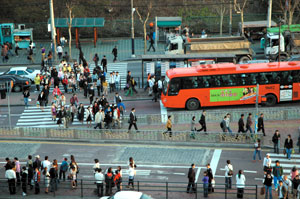
▲ Yonsei bus stop: Pedestrians are tempted to cross despite the red light
(Photographed by Kim Young-sung)
No doubt Yonsei is situated in one of the most complicated and congested areas in Seoul. Yet, how well prepared are we to protect ourselves from the danger that looms large? Still, students cross back and forth from the Central Library to the Student Union without paying much heed to passing cars. Furthermore, scooters and motorcycles whiz past passers-by, nearly knocking them over. Even today, the traffic signal at the mid-lane bus stop in front of Yonsei changes alternately, luring students to jaywalk unaware of the danger that lies ahead. It is true that Yonsei is not located in the best of traffic situations, but little by little those problems must be solved through awareness by both those who are in potential danger, as well as those who have the authority to take the initiative and make the changes. With continued effort, perhaps, a day may come when Yonsei students will be able to enjoy a college life in Shinchon, though not necessarily in its traumatic traffic madness.
| Spotlight IF YOU want to see what traffic in Shinchon is like in a glance, climb to the top of the building right across from the Hyundai Department Store exit, stand at the edge and look down at the "x-shaped" crosswalk when the pedestrian light turns green at 8:40 a.m. If you don't quite get the idea of what traffic in Shinchon is like, try taking a taxi at 8:45 a.m. on Myungmul Street. If you still don't get the picture, stand still and linger for a while at the traffic light in front of Yonsei. at 8:50 a.m. and watch the backs of all those students zigzagging through the maze of stalled buses and cars. Then, probably, you'll get the idea of what traffic in Shinchon means, and if you're smart enough, you'll start trying to DO something about it! As a reporter for a school magazine, I realized that what I could do within my power was to write an article about the traffic problems students face every day in Shinchon. It was my little wish to increase student awareness about this matter - why don't you join me and suggest your own solution? <L.Y.S.> |

